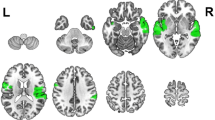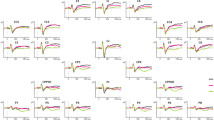Abstract
Prosodic modulation of speech provides information about emotional states of speakers (affective prosodies) or serves as syntactic markers to change linguistic aspects of speech (linguistic prosodies). Previous electrophysiological investigations and studies on patients with right or left hemisphere damage showed nonuniform results with respect to lateralization of prosodic processing. In this study 20 healthy right-handed volunteers were investigated with functional magnetic resonance imaging of the acoustically responsive areas on the supratemporal plane while detecting phonemes as control targets or prosodies in strings of nonsense syllables and adjectives, the latter randomly intonated in a declarative, interrogative, commanding, happy, or sad fashion. In control task A the phoneme /a/ was detected in the syllables. In control task B the phoneme /a/ was detected in the adjectives, and in the experimental task C the sad intonations (affective) and in the experimental task D the interrogative intonations (linguistic) had to be detected in the same material. In task A intensity-weighted volumes of activated voxels were not different in the two hemispheres (laterality index 0). In task B with an irrelevant phoneme detection with respect to prosodic material, the population split into two subgroups with similar right or left hemispheric lateralization of activity leading to an absolute laterality index of 26.8 across all subjects. During detection of affective prosodies (task C), lateralization was maintained yet the absolute laterality index reduced to 14.5, while there was no lateralization during detection of linguistic prosodies. The sum of activations in the two hemispheres was the same across all tasks and subgroups, which suggests that the lateralizations occurring with presentation and detection of prosodic material depend on a redistribution of activity between hemispheres.
Similar content being viewed by others
References
Ackermann H, Hertrich I, Ziegler W (1993) Prosodische Störungen bei neurologischen Erkrankungen—eine Literaturübersicht.Fortschr Neurol Psychiatr 61: 241–253.
Benson DF (1986) Aphasia and lateralization of language.Cortex 22: 71–86.
Bradvik B, Dravins C, Holtas S, Rosen I, Ryding E, Ingvar DH (1991) Disturbances of speech prosody following right hemisphere infarcts.Acta Neurol Scand 84: 114–126.
Cohen MJ, Prather A, Town P, Hynd G (1990) Neurodevelopmental differences in emotional prosody in normal children and children with left and right temporal lobe epilepsy.Brain Lang 38: 122–134.
Cohen MJ, Branch WB, Hynd G (1994) Receptive prosody in children with left or right hemisphere dysfunction.Brain Lang 47: 171–181.
Heilmann KM, Bowers D, Speedie L, Coslett HB (1984) Comprehension of affective and nonaffective prosody.Neurology 34: 917–921.
Lalande S, Braun CMJ, Charlebois N, Whitaker HA (1992) Effects of right and left hemisphere cerebrovascular lesions on discrimination of prosodic and semantic aspects of affect in sentences.Brain Lang 42: 165–186.
Monrad-Krohn H (1963) The third element of speech: prosody and its disorders. InProblems of Dynamic Neurology (Halpru L, ed.) pp. 101–118. Jerusalem: Hebrew University Press.
Ross ED (1981) The aprosodias: functional-anatomical organization of the affective components of language in the right hemispheres.Arch Neurol 38: 561–569.
Tucker DM (1981) Lateral brain function, emotion and conceptualization.Psychol Bull 89: 19–46.
Zaidel E (1985) Language in the right hemisphere. InThe Dual Brain (Benson DF, Zeidel E, eds.) pp. 205–231. New York: Guilford Press.
Blumstein S, Cooper WE (1974) Hemispheric processing of intonation contours.Cortex 10: 146–158.
Bulman-Flemming MB, Bryden MP (1994) Simultaneous verbal and affective laterality effects.Neuropsychologia 32: 787–797.
Pihan H, Altenmüller E, Ackermann H (1997) The cortical processing of perceived emotion: a DC-potential study on affective speech prosody.Neuroreport 8: 623–627.
Silberman EK, Weingartner H (1986) Hemispheric lateralization of functions related to emotion.Brain Cogn 5: 322–353.
Steingrüber HJ (1971)Hand-Dominanz-Test. Göttingen: Verlag für Psychologie.
Baumgart F, Tempelmann C, Gaschler B, Schindler F, Stiller D, Heinze HJ, Scheich H (1995) Separate fields in human auditory cortex identified: a 3T fMRI study (Abstract).3 rd Annual Proceedings of the Society for Magnetic Resonance, p. 1344.
Gaschler B, Schindler F, Scheich H (1996) KHORFu: a KHOROS-based functional image post processing system. A statistical software package for functional magnetic resonance imaging and other neuroimage data sets (Abstract).COMPSTAT XII: Symposium on Computational Statistics, Barcelona, Spain, pp. 57–58.
Bandettini PA, Wong EC, Hinks RC, Tikofsky RS, Hyde JS (1992) Time course EPI of human brain function during task activation.Magn Reson Med 25: 390–397.
Gaschler-Markefski B, Baumgart F, Tempelmann C, Schindler F, Stiller D, Heinze HJ, Scheich H (1997) Statistical methods in functional magnetic resonance imaging with respect to nonstationary time series: auditory cortex activity.Magn Reson Med (in press).
Galaburda AM, Sanides F (1980) Cytoarchitectonic organization of the human auditory cortex.J Comp Neurol 190: 597–610.
Bortz J, Lienert GA, Boehnke K (1990)Verteilungsfreie Methoden in der Biostatistik. Berlin: Springer Verlag.
Wheeler RE, Davidson RJ, Tomarken AJ (1993) Frontal brain asymmetry and emotional reactivity: a biological substrate of affective style.Psychophysiology 30: 82–89.
Binder JR, Rao SM, Hammecke TA, Yetkin FZ, Jesmanowicz A, Bandeltini PA, Wong EC, Estkowski LD, Goldstein MD, Houghton V (1994) Functional magnetic resonance imaging of human auditory cortex.Ann Neurol 35: 662–672.
Binder JR, Frost JA, Hammecke TA, Cox RW, Rao SM, Prieto T (1997) Human brain language areas identified by functional magnetic resonance imaging.J Neurosci 17: 353–362.
Dhankhar A, Wexler BE, Fulbright RK, Halwes T, Blamire AM, Shulman RG (1997) Functional magnetic resonance imaging assessment of the human auditory cortex response to increasing word representation rates.J Neurophysiol 77: 476–483.
Safer MA (1981) Sex and hemispheric differences in access to codes for processing emotional expressions and faces.J Exp Psychol [Gen] 110: 86–100.
Carmon A, Nachshon I (1973) Ear asymmetry in perception of emotional non-verbal stimuli.Acta Psychol (Amst) 37: 351–357.
Ouellette GP, Baum SR (1993) Acoustic analysis of prosodic cues in left- and right-hemisphere-damaged patients.Aphasiology 8: 257–283.
Blonder LX, Bowers D, Heilman KM (1991) The role of the right hemisphere in emotional communication.Brain 114: 1115–1127.
Bowers D, Coslett HB, Bauer RM, Speedie LJ, Heilman KM (1987) Comprehension of emotional prosody following unilateral hemispheric lesions: processing defect versus distraction defect.Neuropsychologia 25: 317–328.
Vikingstad EM, Cao Y, George KP, Faull J, Johnson A, Welch KMA (1997) A new approach to studying language lateralization using Bold contrast functional MRI (Abstract).5 th ISMRM meeting, Vancouver, p. 700.
Gainotti G (1989) Disorders of emotions and affect in patients with unilateral brain damage. InHandbook of Neuropsychology (Boller F, Grafman J, eds.) vol 3, pp. 345–361. New York: Elsevier.
Ross ED, Mesulam MM (1979) Dominant language functions of the right hemisphere?Arch Neurol 36: 144–148.
Tucker DM, Watson RT, Heilman KM (1977) Discrimination and evocation of affectively intoned speech in patients with right parietal disease.Neurology 27: 947–950.
Jürgens U, von Cramon D (1982) On the role of the anterior cingulate cortex in phonation: a case report.Brain Lang 15: 234–248.
Spence S, Shapiro D, Zaidel E (1996) The role of the right hemisphere is the physiological and cognitive components of emotional processing.Psychophysiology 33: 112–122.
Kinsbourne M (1978) Evolution of language in relation to lateral action. In:Asymmetrical Function of the Brain (Kinsbourne M, ed.) pp. 553–556. New York: Cambridge University Press.
Reznik JS, Kagan J, Snidman N, Gertsen M, Baak K, Rosenberg A (1986) Inhibited and uninhibited children: a follow-up study.Child Dev 57: 660–680.
Rothbart MK, Derryberry D (1981) Development of individual differences in temperament. InAdvances in Developmental Psychology (Lamb ME, Brown AL, eds.) vol. 1, pp. 37–86. Hillsdale, NJ: Erlbaum.
Author information
Authors and Affiliations
Rights and permissions
About this article
Cite this article
Stiller, D., Gaschler-Markefski, B., Baumgart, F. et al. Lateralized processing of speech prosodies in the temporal cortex: a 3-T functional magnetic resonance imaging study. MAGMA 5, 275–284 (1997). https://doi.org/10.1007/BF02595045
Received:
Accepted:
Issue Date:
DOI: https://doi.org/10.1007/BF02595045




